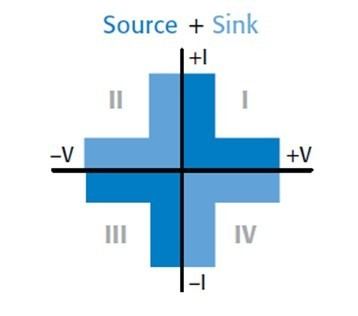 | ||
The Source measure unit (SMU) is a type of test equipment which, as the name indicates, is capable of both sourcing and measuring at the same time.
Contents
Overview
The source measure unit (SMU), or source-measurement unit as it is sometimes called, is an electronic instrument that is capable of both sourcing and measuring at the same time. It can precisely force voltage or current and simultaneously measure precise voltage and/or current.
SMUs are used for test applications requiring high accuracy, high resolution and measurement flexibility. Such applications include I-V characterizing and testing semiconductors and other non-linear devices and materials, where sourcing voltage and current source span across both positive and negative values.To accomplish this, SMUs have four-quadrant outputs. For characterization purposes SMUs are bench instruments similar to a curve tracer. They are also commonly used in automatic test equipment and usually are equipped with an interface such as GPIB or USB to enable connection to a computer.
History
Semiconductor characterization led to the development of Source Measure Units. The HP4145A semiconductor parameter analyzer introduced in 1982 was capable of a complete DC characterization of semiconductor devices and materials. It consisted of four independently controlled source monitor units (the precursor to source measure units) enclosed in a mainframe.
The Keithley 236 introduced in 1989 was the first stand-alone SMU and allowed system builders to integrate one or more SMUs with a separate PC control. Over time stand-alone SMUs have evolved to offer a broader range of current, voltage, power level and price points for applications beyond semiconductor characterization. Smaller form factors made possible through the use of modern computing technologies have allowed system builders to integrate SMUs into rack and stack systems for larger scale production test applications.
Operation
An SMU integrates a highly stable DC power source, as a constant current source or as a constant voltage source, and a high precision multimeter.
It typically has four terminals, two for source and measurement and two more for kelvin, or remote sense, connection. Power is simultaneously sourced (positive) or sinked (negative) to a pair of terminals at the same time as measuring the current or voltage across those terminals is done.
SMU vs. Power Supply
The most important difference is that an SMU has four-quadrant operation (source and sink) compared to a power supply which has two-quadrant (source only) operation. This flexibility enables the SMU to be use for such applications as characterizing batteries, solar cells, or other energy generating devices. SMUs also offer greater speed and precision and typically support wider operating ranges.
SMU vs. DMM
The built-in sourcing capabilities of an SMU work with the instrument’s measurement capabilities to reduce measurement uncertainty and support low current and more flexible resistance measurements. In voltage measurements system-level leakage can be suppressed more easily than with separate instruments. In current measurements, the SMU’s design reduces voltage burden. For resistance measurements, SMUs provide programmable source values, useful for protecting the device being tested.
Significant Features
Notable features of SMUs include the following:
